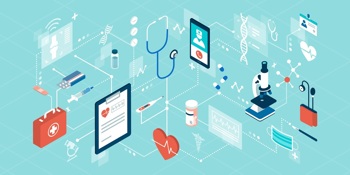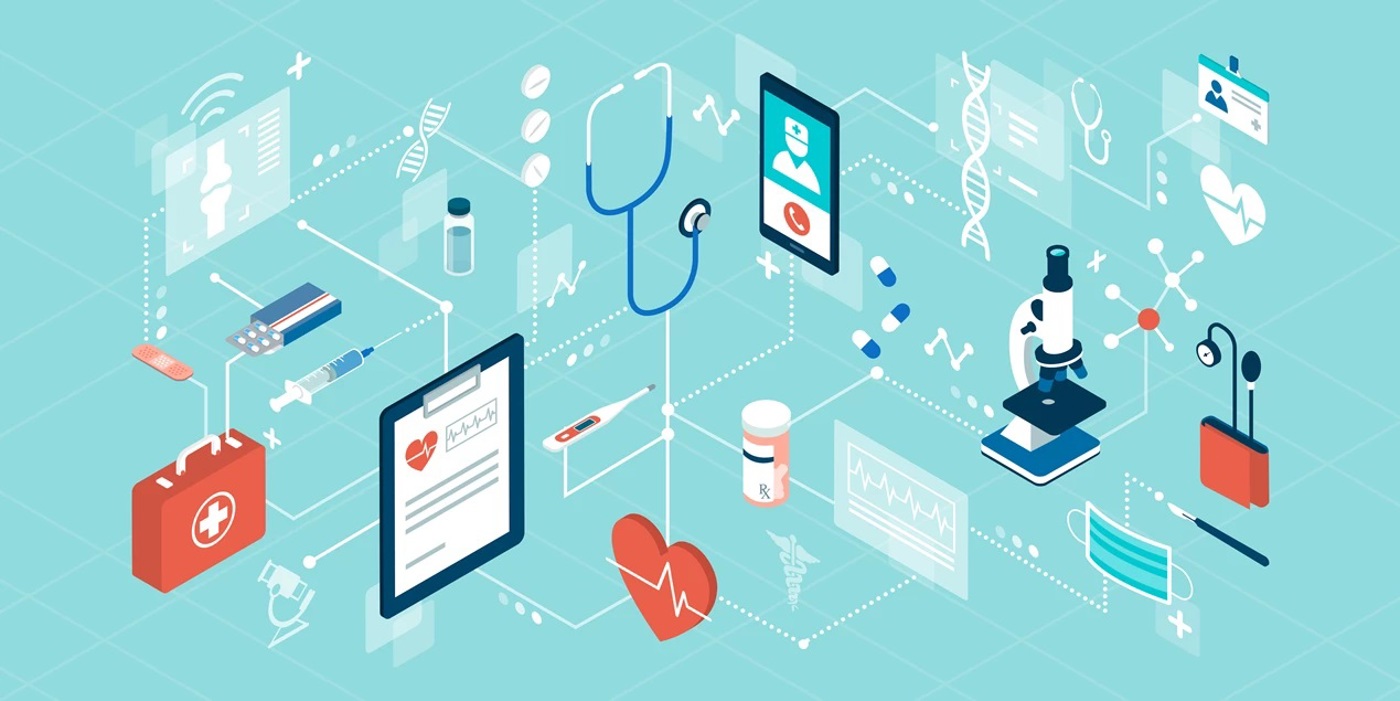 HSC Support
HSC Support
What is telehealth and how does it benefit us?
Telehealth and telecare has become more and more popular in past few years. In fact telehealth usage increased dramatically in 2020 with 80% physicians and 22% of consumers using virtual visits.
Telehealth provides great benefits to to individuals and their loved ones, as well as health and social care professionals. The benefits of telehealth can help individuals increase their independence, reduce their dependency on GPs, as well as provide loved ones reassurance their loved ones are safe and well.
Despite the rise in communities, local authorities, and people using telehealth services there can be confusion in what telehealth actually is compared to telecare and telemedicine.
Table of Contents
If you are a local authority or a health or social care provider you may be wondering what the difference between telehealth, telemedicine, and telecare is and how they all differ? You may also be wondering why telehealth is important and what the difference between telehealth and digital telehealth solutions are?
At Access Assure, we know about the importance of digitally transforming your services to help your end-users get the best outcomes to prolong future care needs and help overcome the challenges facing the social care market currently.
Here is a guide defining what telehealth is and how it can help end-users, their families, carers, and health and social care professionals manage long term conditions more efficiently through increasing patient engagement, improving provider communications and much more.
Through summarsing the challenges and benefits of telehealth this guide will also provide you the best ways to overcome the challenges of telehealth.
What is telehealth?

What is telehealth?
Telehealth is a process a healthcare professional can provide to an individual without an in-person consultation. It uses all types of technological communications including: smart phones, tablets, computers, as well as wearable technology such as: smart watches, and smart glasses to manage medical conditions more efficiently.
Telehealth is often used to support individuals suffering with long-term health conditions such as: chronic obstructive pulmonary disease, heart failure, type 2 diabetes, and mental health conditions to name a few.
Aiming to increase independence and delay future care needs, the national vision for telehealth is to consider it for every individual living with a long term condition to help individuals reach their independent living goals and remain at home for longer.
Asynchronous vs Synchronous telehealth
When using telehealth services it is important to note that there are two different types, asynchronous and synchronous.
Asynchronous telehealth can be described as a store and forward transmission of services. Here medical images and data can be transferred over a period of time, normally in separate time frames as the communication between a health or social care professional and the individual is not live.
Information that individuals send remain stored until the health or social care professional can review and send back information. This type of telehealth is often popular within dermatology, radiology, and cosmetic surgery. Some examples of asynchronous telehealth include:
- Texting between patient and a provider
- Wound/ rash imaging
- Patient report sharing
- Symptom surveys
Synchronous telehealth however, happens in real-time. Often this occurs during an interactive video call where information is shared on both sides during the same time period. Synchronous telehealth and virtual visits can be used interchangeably and some examples include:
- Live video calls
- Real-time behaviour observation
- Phone call about symptoms
Telehealth vs digital telehealth – What’s the difference?
Telehealth and digital telehealth normally get used interchangeably, however some health and social care professionals and organisations may use them slightly differently.
Telehealth is often the broader term used to encompass the delivery of healthcare services and information using telecommunication technologies. It often then includes a wide range of remote healthcare services, such as consultations, diagnosis, treatment, and monitoring which are usually provided through video calls, phones calls and messaging.
Digital telehealth on the other hand specifically relates to services that are delivered through digital technologies and platforms which emphasises the use of digital tools such as video conferencing software, mobile health apps, and other digital technologies to facilitate the healthcare delivery.

Why is telehealth important?
Telehealth is important for several different reasons, as it helps to address and overcome a number of health and social care challenges and provides a variety of benefits for individuals and their families, clinicians, local authorities, and care providers too.
Some of the main reasons why telehealth is important include:
- Helps to increase access to healthcare
- More convenient
- Offers more timely care
- Better continuity of care
- Quicker access to specialists
- Reduced exposure to illness
- Cost savings
- Offer more discreet mental health support
- Better chronic disease management
- Reduces hospital readmissions
- Offers better emergency care before seeking in-person care
- Offers more flexible scheduling
- Environmental benefits
- Helps reduce health and social care disparities for marginalised populations
- Helps improve overall understanding of health and social care trends and outcomes
- Better support for rural and underserved areas
- Offers better person-centred care

Download our guide to learn how Technology Enabled Care (TEC) works and how it aims to transform social care for the better.
Telehealth services – what are they?
Telehealth services provide a variety of virtual support and care which is helpful in monitoring and improving ongoing issues with patients.
Depending on the patient the amount of telehealth that is used will differ. Some may benefit from a phone or video consultation due to mobility issues, others may benefit from online messaging services due to their busy lifestyles.
Ultimately, the decision of whether telehealth will benefit a patient is decided by health and social care professionals, but with the dramatic increase in the use of telehealth, its services are becoming more versatile to help a wider variety of patients. Some examples include:
1. People suffering with chronic conditions
Telehealth services helps patients connect to care teams to track plans and connect patients with pharmacies to organise and sort queries regarding prescriptions.
2. People suffering with different mental health conditions
Both counselling and support can be delivered remotely and help patients find consultations more comfortable.
What is a virtual visit?
Virtual visits, are a type of telemedicine where patients and health or social care providers interact in a virtual environment. These can take place via video calls, audio calls, or text messages. Virtual visits are often used for routine check-ups, follow -up appointments, or minor health concerns without the need for an in-person visit. During the first few months of the pandemic the number of virtual visits alone rose by 48% across the UK.
There are three key ways a virtual visit can work:
1. By a phone/video call
Like a standard GP appointment, patients can discuss their symptoms and condition with a healthcare professional over the phone or a video call, reducing time spent travelling to GP practices or hospitals and making it as stress free as possible.

2. Online messaging services
Using an online messaging service removes the need to schedule an appointment whether it is in person or virtual. It can be an instant way to communicate worries or changes in symptoms in real-time to receive quick advice on how to update treatment plans without taking up any appointment times.

3. Digital applications
Post a virtual visit, doctors may need patients to monitor symptoms virtually and record results in digital applications so both patients and healthcare professionals can monitor and track conditions and compare data easily.
Talk to our telehealth and telecare expert to see what software is best for you!
Telehealth vs Telemedicine Vs Virtual Care
Telehealth, telemedicine, and virtual care are all terms that refer to the use of technology to provide healthcare services remotely. All do have some similarities but there are important distinctions of all three to be aware of.
Both telehealth and telemedicine have been used interchangeably, but there are differences. Telehealth focuses on the overall provision of healthcare services involving both clinical and non-clinical activities such as remote patient monitoring, medical education, and administrative tasks. Telemedicine on the other hand is a subset of telehealth referring specifically to the practice of medicine over a distance using technology. It mainly focuses on the clinical aspect of healthcare delivery looking at medical diagnosis, treatment planning and patient care.
Both are equally important to support people with long term conditions to self-manage, reduce hospital stays, allow early hospital discharge, and reduce reliance on primary health and GP practices in a time where waiting times for appointments and treatments are soaring.
Virtual Care, however, is a broader term that includes both telehealth and telemedicine and both clinical and non-clinical services through technology without the need for in- person contact.
Virtual care can also incorporate a lot more services, as well as typical telehealth and telemedicine consultations, it can also include remote monitoring, health education, and more administrative tasks such as appointment scheduling and prescription refills. It is normally used to be more convenient and person-centred to the individual by offering a more holistic approach around their schedule through digital means.
Telehealth vs Telemedicine Vs Virtual Care – Pros and Cons
There are a number of advantages and disadvantages of telehealth, telemedicine, and virtual care. Often the disadvantages of all three are due to either a lack of understanding of what they are and what they can do as well as a lack of understanding of how to implement these new approaches successfully so everyone in a community can benefit.
The table below breaks down further the pros and cons of telehealth, telemedicine, and virtual care for end-users and their families, clinicians, care providers, and local authorities too.
|
|
Pros |
Cons |
|
Telehealth |
1. Improves patient engagement – increases responsibility in managing their own health and wellbeing 2. Increases confidence – individuals have the ability to self-manage conditions 3. Improves patient education - individuals can learn triggers which can worsen their condition to know how best to cope, manage, and prevent symptoms worsening 4. Better person-centred care – dual management between health and social care providers and the individual allows individuals to understand their treatments better 5. Increased efficiency – individuals can access healthcare whenever and wherever they are to best suit them 6. Reduces waiting times 7. Reduces time needed to travel 8. Waiting times for specialist help is reduced 9. Improves education and training -Blended learning approaches using mobile platforms can be used to meet requirements and prepare for board exams 10. Improves provider communications –allows clinicians and health and social care providers to share information about treatment plans and Primary Care Providers (PCPs) can receive specialist advice and help sooner 11. Offers a comprehensive scope – encompasses a broad range of healthcare services 12. Offers better preventative and proactive care 13. Reduces healthcare disparities 14. Improves access to services for older adults and those living in rural areas |
1. Technical challenges – individuals may struggle using certain equipment and technology limiting its effectiveness 2. Accessibility – some individuals may have not have internet limiting their telehealth options 3. Digital literacy – not all individuals will have the same digital understanding, more training and specialist help will be needed 4. Privacy concerns – individuals can be concerned about their data being breached, ensuring your data security is finalised is essential but can take time to implement and train staff 5. Limited physical examination – telehealth isn’t the answer for all healthcare there are some physical examinations which have to be done in person. It is crucial health and social care professionals understand the difference |
|
Telemedicine |
1. Offers more focused medical care – ensures a direct focus on medical issues during its remote clinical consultations 2. More convenient – patients can receive timely medical advice without leaving home 3. Better access to specialists who are not local 4. Reduce waiting times 5. Offers a better continuity of care 6. Increases patient engagement and education 7. Can reduce hospital admissions and readmissions 8. Can prevent hospital discharge delays 9. Reduces pressure on clinicians |
1. Technical barriers – limited access to internet and digital literacy, lack of confidence and understanding using tech and equipment needed 2. Limited physical examination – some exams in-person are needed to manage some conditions 3. Regulations – regulations can vary by region limiting the ability to deliver telemedicine services 4. Privacy and security issues 5. Lack of personal connection – impact doctor-patient rapports |
|
Virtual Care |
1. Offers a more innovative option to care – allows technology like AI, remote monitoring and digital health platforms to be used 2. Offers more person-centred care – puts what matters to the individual first 3. Offers more comprehensive approach to care – similar to telehealth 4. Scalability – providers can reach a wider patient base to help reduce health disparities and inequalities 5. Saves time 6. Improves your population health management approach – no needs are left unmet |
1. Technical challenges – internet and accessibility issues can disrupt sessions 2. Limited digital literacy 3. Privacy and security concerns over patient data 4. Diagnostic limitations – some conditions may need certain tests which cannot be provided by virtual care 5. Lack of physical presence – like telemedicine, virtual care can’t replace the benefits of in-person physical examinations |
The table above clearly shows there a lots of benefits of telehealth, telemedicine, and virtual care with many overlapping to improve patient engagement and education so individuals can become more proactive in managing their health and wellbeing. Through using a combination of telehealth, telemedicine and virtual care services, communities can have a better population health management approach so no needs are let unmet.
Equally through using a variety of different technology communications, reminder notifications can be sent to individuals to remind them to take their medication, book appointments, and complete their daily exercises. Remote monitoring can allow clinicians to be able to see how well an individual is coping with their condition from afar and offer more support and guidance when needed before something critical takes place.
Using different digital health platforms can offer individuals and their families more informative and interactive videos or posts within a mobile app of suggestions on how to make better lifestyle choices. For example, these could be about weight loss and reducing fat and sugar intake to prevent diabetes type 2, to support on quitting smoking or vaping. Detailed information can also be given on how to maintain treatments at home, as well as how to set up any specific equipment and technology needed.
An important thing to also note is the benefits using telehealth services has on both older adults and for individuals that live in rural areas. There can be some challenges in providing telehealth to older adults, however once these challenges are addressed using telehealth can help older adults become more confident in how to use different technology to better manage their own health, increase independence, and help to reduce hospital admissions (often through using more digital telecare or technology enabled care within the home).
Offering telehealth in rural areas also offers a number of benefits. Often rural areas have limited access to different health and social care facilities. Telehealth ultimately helps bridge this gap by making essential medical services more accessible through both remote consultations and monitoring. Time and travel burdens can also be reduced and through offering better chronic disease management, individuals no longer have to rely on GPs so much when waiting times are already so long.
The table above however, clearly does show there are some cons to telehealth, telemedicine, and virtual care, but a lot of them are similar and can easily be avoided.
One of the best ways to do this is understand your community. That way your local authority will have a better understanding of who is at risk of having limited telehealth access. A lot of the disadvantages of telehealth as a whole can come from a lack of understanding. It is important therefore when introducing it that clinicians, local authorities, and health and social care providers, that you work together to demonstrate that telehealth is not a replacement for in-person health and social care, but more an additional service to deliver more outcomes-focused care which allows individuals to still be cared and supported for at home, as well as offer more convenience for individuals with busy lifestyles.
Challenges of Telehealth 2024
Like discussed above there are some cons to using telehealth services. One of the biggest challenges of telehealth and in particular telemedicine is the lack of legislation and regulations currently in the UK. Because of this these services are regulated in the same way as other healthcare services.
Under the Health and Social Care Act 2014, transport services, triage and medical advice provided remotely is a regulated activity which the CQC considers telemedicine to sit under. Providers in England therefore must register with the CQC to show they meet all the necessary requirements.
Due to the lack of regulations, a lot of governing bodies have released advice on remote consultations which are often continually updated. To overcome this challenge it is essential therefore your care providers, clinicians, and local authorities keep up to date with the latest updates.
The British Medical Association, offers advice which also emphasizes the importance of safeguarding and confidentiality of patients. Through following this advice your local authority can also help reassure uncertain users of telehealth that their data is safe as well as the other benefits telehealth can provide them.
How to start using telehealth:
The demand of telehealth services have been increasing since the pandemic. Studies into the preference of telehealth have indicated that between 94- 99% of patients reported to be “very satisfied” with the telehealth services they had received. A third of the patients also highlighted that they preferred a telehealth visit compared to a more traditional service.
This guide has reviewed both the benefits and challenges of using telehealth services to help your local authority offer better services to your community which concentrates on delivering more preventative and proactive care.
In order to start using telehealth or improve your existing services, using a population health approach can help fully understand the needs of your community, who will benefit the most from using telehealth services, and who will need more support.
Once your local authority has gained that understanding it will be easier to make it more widespread and successful in your community to delay future health and social care needs, improve independence, and deliver a better continuity of care.
Concluding what is telehealth
This guide has explained what telehealth is and how telemedicine and virtual care differs. I have explained how telemedicine is a subset of telehealth predominantly concentrating on the clinical needs of individuals and how virtual care is a broader term which incorporates both telehealth and telemedicine.
Through reviewing the pros and cons of each it is clear all three offer many benefits to individuals, clinicians, providers, and the wider community. This guide has also highlighted the importance of knowing and understanding the challenges and disadvantages of telehealth which can occur and how best to overcome them so your local authority can successfully implement telehealth into your services or improve your existing services further.
Whether your local authority uses asynchronous or synchronous telehealth or both there are a variety of benefits which can improve convenience, access and efficiency of delivering health and social care.
At The Access TEC our digital telecare equips a variety of users with a proactive digital solution to aid day-to-day living including: local authorities, acute trusts, and providers of domiciliary care.
Our focus in supporting both caregivers and care receiver’s alike help make better decisions in treatment plans to improve patient outcomes.
Care providers can also benefit from integrations with our care planning software allowing care workers access to smart alerts and alarms from the Assure hub in our care planning app. This, in turn, helps to deliver better proactive care enabling better data-led decisions that ensures care services are safe, effective, and high quality through the real-time updates they receive to gain a fuller picture of an individual’s wellbeing and identify risks before something more critical takes place.
Discover our technology enabled care ecosystem today and the benefits our technology-enabled care can offer to help educate, manage, monitor, and maintain long term medical conditions to improve both the physical and mental wellbeing of individuals in your community.

